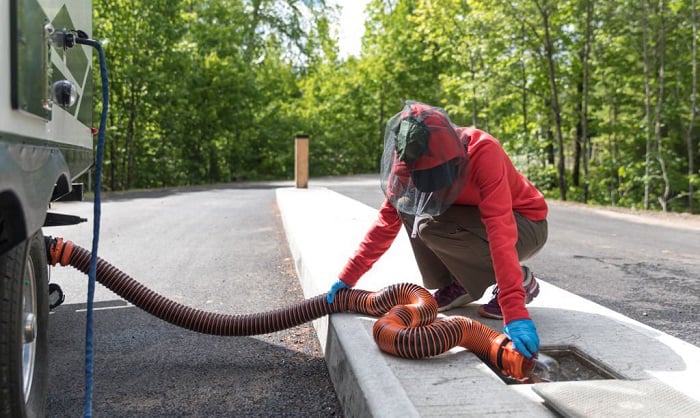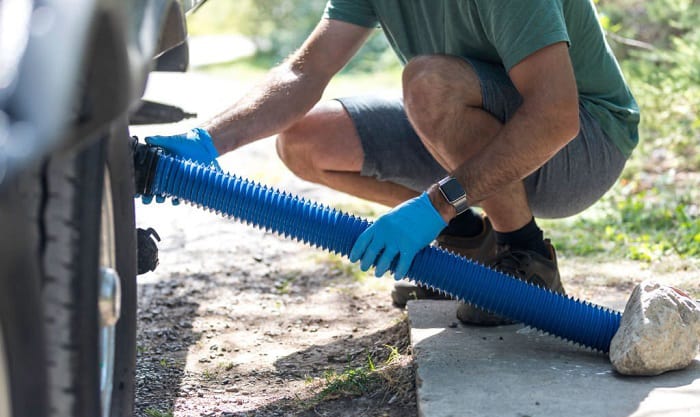Page Contents
Dumping waste from your RV is illegal in many locations, which is why you’re possibly looking for a way to build a dump station easily. However, you’re still wondering how to build an RV dump station.
Here, you’ll find out the solution to that concern. We’re going to list down the things you’ll need for the project, plus the essential guidelines to help you every step of the way.
6 Steps to Build an RV Dump Station
Developing an RV dump station might look complicated and challenging. However, the process is reasonably straightforward, especially if you have all the essential equipment.
What You’ll Need
Before you can start developing an RV dump station, you need to secure the necessary items first. Take note of the following tools as you’ll need them throughout the project.
- Safety Gear
RV wastes can be a collection of hazardous substances that can increase the risks of illnesses with contact. Therefore, you should wear safety equipment like gloves, rubber boots, and a respirator.
But if you’re dealing with a significant amount of waste from your motorhome, consider wearing a full-body protective suit. In turn, you can avoid accidental touches of harmful substances with parts of your body.
- Wedge
A wedge is a versatile tool to separate two or more objects. Use this device to help unscrew the caps at the top of cleanout stations, which are the points that allow you to put one end of drainage hoses.
Using wedges can also help ensure that the hose is secure. Otherwise, operating the dump station without a secure connection for the hose can bring about spillage.
- Sewer Hose
You’ll need a reasonably durable hose to connect your RV’s waste tank to the dump station. In some cases, you may also need to use two hoses; one to connect to the drain tank and the other to supply clean water during cleanups.
Take note that different sewer hoses exist on the market. Make sure that the model you’re purchasing has excellent crush protection and abrasion resistance. These features promote security during use to reduce tears, which would otherwise cause spills.
- High-Pressure Water System
The motorhome or travel trailer should be near a high-pressure water system, such as a hydrant, to clean the dumping area after the operation. Make sure to follow location guidelines to know if you can park your vehicle near a hydrant.
- RV Dump Station Water Kit
If you find it challenging to procure each required item separately, you can buy an RV dump station kit to help ease the preparation process.
A general RV waste dumping kit will have parts like a vacuum breaker, headspring, nozzle, shutoff valve, hose, and body pipe.
Step-by-Step Instructions
Step 1: Follow Guidelines
The first part of building an RV dump station is to find out whether you can install the waste removal site in the area. Make sure it’s legal to build a dumping spot in the park, city, and state to avoid charges and fines.
Contact local authorities to guide you in your next step. Consider other options to dump your camper’s wastes if the state doesn’t allow building an RV dump station in a specific plot of land.
If your region allows the development of RV waste disposal units, make sure to follow the recommended station layouts. For example, the Indiana State Department of Health has a guide on the state’s suggested look for dumping stations.
Step 2: Create a Slope Pad
Many RV dumping stations follow a general design. The first step to developing one is to build a concrete slope pad. This part allows easy access to users to the waste disposal unit without putting unwanted strain on certain components, such as the hose.
Generally, the sloped pad should be at least an inch per ten feet per drain. Additionally, it should also extend at least two feet in all directions from the drain.
Step 3: Connect a Cap
Ideally, the RV dumping station should have a cap connected to a foot-operated mechanism. For instance, stepping on a nearby button will open the cap, and you can move your foot to close it.
The RV dump cap should also be sufficiently durable to withstand multiple uses. One of the last things RVers want is for the cap to become ruined during waste disposal operations, causing significant spills in the area.
Many durable dump caps for RV waste dumping stations have heavy-duty plastic construction. Some models can even last for years, thanks to extra features like high UV resistance.
Step 4: Develop a Sturdy Sewer Line
Make sure that the sewer line that connects the drain to the RV’s tank has a diameter of at least four inches. Additionally, this part should have a construction of the recommended material to provide users with peace of mind while dumping their wastes.
Furthermore, this sewer line should have at least a ten-foot horizontal partition between it, the water system, and the tank.
Step 5: Install a Water Supply Distribution Tap
Water supply distribution taps allow RVers to flush and clean the station after each use. Also, the tap should use materials that follow your location’s Plumbing Code. The water supply line should also have back-siphonage protection.
Step 6: Put Up a Sign
The sign near the dumping station should read ‘Not Safe for Human Consumption. Only Use for Cleaning and Waste Flushing Purposes Only.’
Take note that you might not restrict yourself to using these words on the sign. But you might still need to follow park, city, or state policies in using the appropriate words on the RV waste disposal signage.
Is Dumping RV Sewage Illegal?
The consensus for many locations where RV parking is allowed is that it’s illegal to dump RV sewage in public spaces. Therefore, RVers should take the time in building their RV dump stations to avoid fines and sanctions.
Furthermore, RV owners need to follow specific guidelines when dumping their wastes in dump stations. For instance, the County of Los Angeles Department of Public Health office states that RV dump stations should be cleaned and disinfected each day.
Additionally, here are other general rules to follow when building an RV dump station and discarding waste:
- The dumping station needs to have a hose with a reasonable diameter to reduce machine strain during operations.
- Use a tight-fitting drain cover with a foot-operated attachment to prevent spillage and odors from escaping without the risk of direct skin contact.
- Only use a recommended hydrant or water outlet next to the waste removal
- Only use an approved atmospheric vacuum breaker to significantly reduce the risks of backflows into the water supply system.
- Use a flexible hose of adequate length.
- Post a sign near that RV dumping station that says, ‘Unsafe for drinking’ or something similar.
Failure to comply with these rules can result in dire consequences. Some locations can even ban RV owners from returning to campsites because they failed to observe these RV waste dumping rules.
Other Things to Consider
Aside from the steps mentioned above, the following things can become requirements to building an RV dumping station:
- Build a backflow prevention device. This machine prevents wastewater from returning to the tank or a freshwater system, which would otherwise cause costly issues.
- Have a certified inspector check the work. After building the RV dump station, call a professional examiner to inspect the work. Following all the guidelines should net you a seal of approval for long-term operations.
- A holding tank should have a water-tight design. If you add a holding tank, make sure that it’s capable of holding a relatively significant amount of waste volume. In general, it should hold about 1,000 gallons of sewage.
Conclusion
Did you find this guide on how to build an RV dump station helpful? Take note that you need to gather the right materials and tools for a proper waste-dumping session. Also, don’t skip the steps mentioned above to avoid risks of issues like spillage.
Do you have an RV dump station situation that you’d like to share? Perhaps you’d like to ask us questions about dumping waste from your campers. If so, mention them in the comments.
Furthermore, if you want to dump RV tanks at home, don’t forget to click here for more!
“Hi, I’m Francis’ husband—Calvin. Our story began with our shared passion for traveling. I have had a career journey for over 11 years at Ford Motor Company, where I took on the role of BMS SW Process Engineer.
Together with my wife, I have dedicated countless hours to exploring every nook and corner of the world. Ten years living in an RV may seem long, but time seems to fly by when I’m doing what I love with the person I love.
FMCA’s 103rd International Convention & RV Expo in Gillette, WY,
Like my wife, I hope to help you see the beauty of traveling off the beaten path by sharing insights into this lifestyle. In addition to my corporate roles, I also launched our website – Outdoorbits, in 2015 and continue to contribute my knowledge and skills to the present day. And I’ll be completely honest with you—no hiding the truth or sugarcoating the possible challenges.
So, if you want to run away from the busy lifestyle to embrace nature, I’m your guy.”









